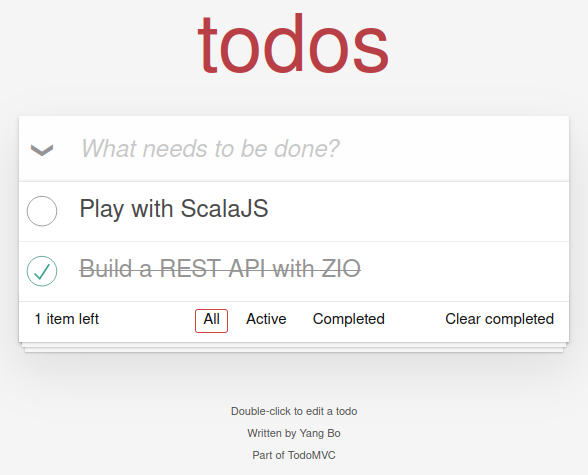A TODO Application
This scaffolding project expose a typical architecture for a TODO Fullstack application would consist of both front-end and back-end components.
 The Frontend view of the ScalaJS Fullstack Frontend application
The Frontend view of the ScalaJS Fullstack Frontend application
This projects aims to provide a fullstack Scala Web Application using ScalaJS (opens in a new tab), Zio (opens in a new tab), and a way to persist information in at least one database management system.
Features
🚀 Discover the amazing features of our TODO Application! 🌟
- Easy project setup with a ready-to-use Frontend and Backend application. Get started in no time! 😎
2️. Choose your favorite database with just one click: Postgres or MongoDB. It's all about flexibility! 🗃️
3️. Seamlessly deploy your project using Docker. It's smooth sailing all the way! 🐳
Don't miss out on this opportunity to build your dream full-stack application with ScalaJS and Zio. Get productive and unleash your creativity today! 💪🔥
A Scaffolding project
In computer science, scaffolding refers to a technique or practice used in software development to provide a temporary
framework or support structure for building applications.
It is a process of creating a basic structure or skeleton code
that helps developers quickly set up the foundation of an application
or system before adding specific functionalities.
Scaffolding typically involves generating or auto-generating code, templates, or frameworks that provide a starting point for development. This can include boilerplate code, directory structures,
- models, user interfaces, or other components that are commonly needed in an application. The purpose is to streamline the development process, reduce repetitive tasks, and accelerate the initial setup of a project.
Scaffolding tools or frameworks are often used in web development, where they can generate basic code templates for creating models, views, controllers, database migrations, and other components of a web application. These tools enable developers to quickly establish a project's structure and focus on implementing the specific business logic or features without starting from scratch.
Scaffolding can be particularly useful in rapid prototyping, where speed is prioritized over fine-grained customization. Once the scaffolding is in place, developers can modify or extend the generated code to meet the specific requirements of the application.
What to do next ?
You can dive into the structure of the application in the about section.